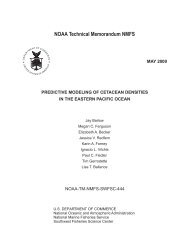NOAA Technical Memorandum NMFS - Southwest Fisheries ...
NOAA Technical Memorandum NMFS - Southwest Fisheries ...
NOAA Technical Memorandum NMFS - Southwest Fisheries ...
You also want an ePaper? Increase the reach of your titles
YUMPU automatically turns print PDFs into web optimized ePapers that Google loves.
VHF radio and received using a modified ICOM broadband radio receiver (ICOM IC<br />
R100) in the acoustics lab. Sonobuoy recordings were made using a portable Sony digital<br />
audio tape (DAT) recorder (Sony TCD-7 or TCD-8), or with a rack-mounted Sony PCM-<br />
R500 DAT (48 kHz sampling rate). Information regarding sonobuoy deployments and<br />
recordings were entered into a separate logbook.<br />
D. Hull-mounted Hydrophones<br />
A three-element hydrophone array was mounted to a plate bolted into one of the<br />
underwater ports of the ‘bow bubble’ of the Jordan (Fig. 2c). The three hydrophones<br />
were arranged in a triangular pattern, with a maximum separation of 21 cm. The<br />
frequency response of the bow hydrophone was 500 Hz to 30 kHz (± 5 dB at -155 dB re<br />
1V/µPa). The output of the bow hydrophones was sent to the acoustics lab, where signals<br />
could be monitored independently or simultaneously with the towed hydrophone array.<br />
Due to high noise levels, the bow hydrophones have a limited acoustic detection range,<br />
and were used primarily to detect bow-riding dolphins and cetaceans located in close<br />
proximity to the bow of the ship. These were areas where the towed hydrophone array<br />
had limited detection abilities.<br />
E. Data Analysis<br />
In this report, acoustic detection will be used to refer to the presence of<br />
vocalizations attributed to a single animal or a group of cetaceans. Acoustic detections<br />
were divided into two categories: those also detected by the visual team (matched<br />
detections) and those that were not detected by the visual team (exclusive acoustic<br />
detections). Cetacean sightings in which vocalizations were not detected using our<br />
methods were considered exclusive visual detections. If only a few vocalizations were<br />
detected (









